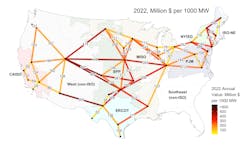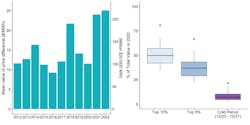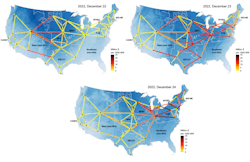Potential Savings of New Transmission was Higher Last Year than at Any Point in Last Decade
In 2022, additional transmission could have reduced electric system costs by more than in any year from 2012 through 2021, according to recent market data from Lawrence Berkeley National Laboratory. Generally high electricity prices coupled with extreme weather events and other factors helped drive the high value for transmission.
Transmission congestion-relief values were high in many regions in 2022, with a number of interregional links reaching $200 to $300 million per 1000 MW of transmission capacity (or $23 to $34 per MWh). Additionally, wholesale pricing patterns during winter storm Elliott at the end of 2022 illustrate the role of transmission in helping manage periods of grid stress.
Update with Market Data in 2022
In the fact sheet, Berkeley Lab builds on its past research, focusing on locational price arbitrage as one signal of the value of transmission expansion. The difference in wholesale electricity prices between two locations largely represents the cost of congestion or, conversely, a key potential value of new transmission. While the congestion-based value of transmission analyzed here represents one of the largest sources of transmission value, transmission provides other benefits that it does not measure (including, for example, reliability, resiliency, and emission-reduction benefits). Underlying the congestion-based transmission benefits that are the focus of this factsheet is the simple concept that transmission enables a lower cost set of generators to meet load than would otherwise be available.
Key Findings for 2022
- High transmission value (or equivalently, potential cost savings) existed in most regions in 2022.
- Transmission value was higher last year than at any point in the last decade.
- As in past years, transmission value was concentrated in a small portion of total hours (roughly 50% of value derived from 5% to 10% of hours). The high value of a small set of hours with extreme weather, or unexpected conditions, suggests that planning approaches that do not adequately model or consider these conditions likely understate the economic value of new transmission infrastructure.
- Wholesale pricing patterns during winter storm Elliott illustrate the role of transmission in helping manage periods of grid stress. Transmission moved west to east with the storm. The value during this short period provided up to 20% of annual value for some links
The fact sheet describes important caveats and key limitations to the analysis, including the implications of the ‘marginal’ value calculations and additional context.
See more in the fact sheet at: https://emp.lbl.gov/publications/latest-market-data-show-potential.
Acknowledgements
This work was funded by the U.S. Department of Energy’s Office of Energy Efficiency and Renewable Energy under Contract No. DE-AC02-05CH11231. The authors are solely responsible for any omissions or errors contained herein.



